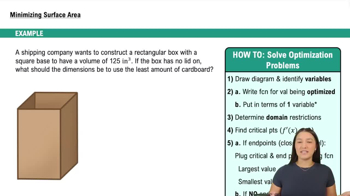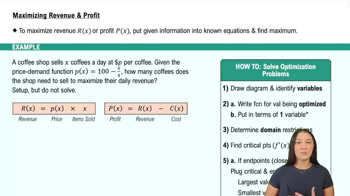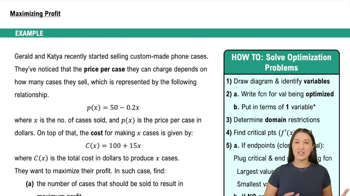Table of contents
- 0. Functions7h 52m
- Introduction to Functions16m
- Piecewise Functions10m
- Properties of Functions9m
- Common Functions1h 8m
- Transformations5m
- Combining Functions27m
- Exponent rules32m
- Exponential Functions28m
- Logarithmic Functions24m
- Properties of Logarithms34m
- Exponential & Logarithmic Equations35m
- Introduction to Trigonometric Functions38m
- Graphs of Trigonometric Functions44m
- Trigonometric Identities47m
- Inverse Trigonometric Functions48m
- 1. Limits and Continuity2h 2m
- 2. Intro to Derivatives1h 33m
- 3. Techniques of Differentiation3h 18m
- 4. Applications of Derivatives2h 38m
- 5. Graphical Applications of Derivatives6h 2m
- 6. Derivatives of Inverse, Exponential, & Logarithmic Functions2h 37m
- 7. Antiderivatives & Indefinite Integrals1h 26m
- 8. Definite Integrals3h 25m
5. Graphical Applications of Derivatives
Applied Optimization
Problem 4.5.68
Textbook Question
Cylinder and cones (Putnam Exam 1938) Right circular cones of height h and radius r are attached to each end of a right circular cylinder of height h and radius r, forming a double-pointed object. For a given surface area A, what are the dimensions r and h that maximize the volume of the object?
 Verified step by step guidance
Verified step by step guidance1
Define the total surface area A of the double-pointed object, which includes the surface area of the cylinder and the two cones. The surface area of the cylinder is given by 2πrh (lateral area) plus the area of the two circular bases, which is 2πr². The surface area of one cone is πr√(r² + h²) (lateral area) plus the base area πr², so for two cones, it is 2(πr√(r² + h²) + πr²). Combine these to express A in terms of r and h.
Set up the equation for the total surface area A: A = 2πrh + 2πr² + 2πr√(r² + h²).
Express the volume V of the object as a function of r and h. The volume of the cylinder is V_cylinder = πr²h, and the volume of one cone is V_cone = (1/3)πr²h. Therefore, the total volume V = πr²h + 2(1/3)πr²h = πr²h + (2/3)πr²h = (5/3)πr²h.
Use the method of Lagrange multipliers or substitute h in terms of r from the surface area equation into the volume equation to express V solely in terms of r.
Differentiate the volume function with respect to r, set the derivative equal to zero to find critical points, and analyze these points to determine the dimensions r and h that maximize the volume.
Was this helpful?

 1:13m
1:13mWatch next
Master Intro to Applied Optimization: Maximizing Area with a bite sized video explanation from Callie
Start learningRelated Videos
Related Practice









